

|
|
To
shortcut the flights from Europe to California (USA) by some thousand
kilometers, the airline SAS (Scandinavian Airline System) opened new routes
over the North Pole in the Ninteen-Fifties. All crews on these flights
had to take part in a special training at the "SAS's Arctic Flight
School". The swiss watch manufacturerer Universal Genève provided
the crews with automatic precision wrist-watches that are resistent against
the strong magnetic field of the polar region. They became the offical
chronometers of SAS.
|
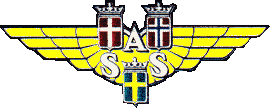
SAS logo with the national flags of Danmark, Norway and Sweden
|
|
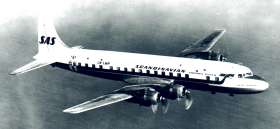 SAS'
Douglas DC 6-B "Leif Viking"
|
On the 15th November 1954 at 19:18 local time the "Helge Viking" (OY-KMI) took off in Copenhagen for the first commercial flight over the North Pole (flight number SK 931). Final destination was Los Angeles (USA). The plane was a Douglas DC-6 B with a wing span of 35.8 m equipped with four 2500 hp Pratt & Whitney propeller engines (18-cylinder twin row radial piston). The maximum cruising speed of this aircraft is 507 km/h. The range is 7600 km with a service ceiling of 25,000 ft. The long-range aircrafts used by SAS had a capacity of 50 to 75 passengers. | |
|
Capt. Povl Jensen
and his crew, incl. the chief pilot and the chief navigator of SAS, flew
via Söndre Strömsfjord (Greenland) to Winnipeg (Canada) where a scheduled
crew-change took place. Above the Canadian tundra they met the sister
plane "Leif Viking" (LN-LMP) that was on its way from Los Angeles to Copenhagen
on the same route. From Winnipeg Capt. Mikal Aschim and his crew continued
the flight to Los Angeles, where they arrived on the 16th November at
22:20 (with a delay of just 3 minutes). The total travelling time was
27 h 15 min and the time airborne was 24 h 25 min. On board of the plane
were the three Prime Ministers of the Scandinavian countries: Hans Hedtoft
(Danmark), Tage Erlander (Sweden) and Oscar Torp (Norway) as well as a
group of prominent journalists.The inauguration of the polar route was
the biggest single aviation event in Scandinavia. In
Copenhagen more than 10.000 spectators joined the ceremony for the departing
plane and, roughly 24 hours later, the ceremonial welcome greeting for
the arriving plane. |
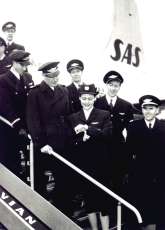 Arrival
in Copenhagen on
16th November 1954 |
|
|
German
newspaper of 16th/17th November 1954 with a first article "live"
from the inaugural polar flight of SAS
|
Following this exploit, Universal Genève introduced a watch with the name "Polarouter" in fall 1954. It was created and designed by one of the most admired watchmakers of the 20th century, Gerald Genta. He later created the "Royal Oak" for Audemars Piguet and the "Nautilus" for Patek Philippe. The Polarouter was, like the models worn by the SAS crews, supplied with the automatic calibre 138 SS with a pendular mass oscillating between two shock absorber. Very soon the watch was renamed to "Polerouter" and then fitted with the famous calibre 215 "Microtor" with a rotating mass incorporated in the movement. Several other Polerouter models followed over the next twelve years. In addition to the classic case with "Bombe" lugs and an inner index ring (Polerouter, Polerouter de luxe, Polerouter Date) new models with different casing-design and dials have been introduced (Polerouter Jet, Polerouter Super, Polerouter Genève, Polerouter Compact, Polerourer "NS", Polerouter III, Polerouter Sub). | |
|
In the 1950's and 60's Universal Genève was the official "timer" on all Royal Viking flights of SAS. This fact was advertised by both parties. The symbolic globe with a flag at the North Pole and the sketched polar-route (see last figure of this page) was modified by Universal Genève an engraved in the steel backs of every "classical" Microtor-Polerouter. In addition the versions delivered to the SAS-Crews were decorated with the SAS logo printed on the dial. Most Polerouter models were available in steel, 18 k yellow and pink gold or with 300 µm gold cap; always provided with a screwed back. A Polerouter had always the status of a high-quality luxurious watch. In the late 1950's a steel Polerouter costs as much as a Rolex Explorer. A Polerouter Date in 18 k gold with a gold bracelet had nearly the same price as a Volkswagen Beetle. After the introduction of the Polerouter Electric in 1963, at the end of the 1980's an unsuccessful attempt was made to revive the name Polerouter with a tasteless Quartz watch. In 1990 a Quartz Polerouter Sport Chrono was introduced. Since then, Universal Genève had not produce watches under the label Polerouter any more. |
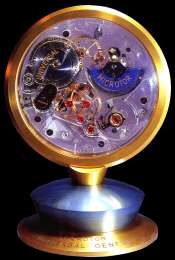 Microtor
model presented at the Bale Fair in 1958
|
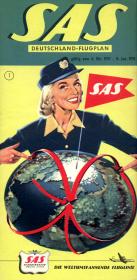
German
SAS timetable
of 1957 |
In 1957 SAS inaugurated the transpolar service Copenhagen-Anchorage-Tokyo with the new Boeing DC-7 C. The flying time was reduced from 52 to 32 hours. By tying together the southern route and the polar route, SAS had earned the right to put "First over the pole and around the world" over the door on its DC-7 C's. But a new era was coming closer - the jet age. Very quickly the new jets like the SE-210 Caravelle and the Douglas DC-8-33 replaced the older propeller machines. Founded in 1946, today SAS is one of the most sucessful European airline with an average of approx. 1,000 flights per day. In 1997 SAS became a founding member of world-wide Star-Alliance network. The present the fleet consists of 152 jet aircrafts (Airbus 340, Boeing 767, 737 and McDonell-Douglas MD81/82/83, MD 87, MD 90-30 and DC 9) as well as 31 propeller aircrafts (Fokker 50, Saab 2000 and deHavilland Q 400). Polar flights became the daily routine of the flight schedule and atomic controlled Quartz watches have replaced the mechanical masterpieces long time ago. |
 |
|
SAS advertisement published in the German news magazin "Spiegel" two days after the inagural flight |
|
|